Cycloteuthis
Cycloteuthis sirventi
Introduction
Cycloteuthis sirventi is easily distinguished from species of Discoteuthis by the general shape which includes a tail. Maximum known size is 480 mm ML (Clarke, 1986). This is probably the most common member of the family but, nevertheless, little is known of its biology.
Brief diagnosis:
A cycloteuthid ...
- with a distinct tail.
- with a large visceral photophore.
Characteristics
- Arms
- Large suckers from arm III with ca. 20 low, truncate teeth (larger distally) around entire margin.
- Large suckers from arm III with ca. 20 low, truncate teeth (larger distally) around entire margin.
- Tentacles
- Suckers nearly equal in size across manus of club.
- Suckers from club manus with ca. 20 teeth, pointed distally and truncated proximally.
 Click on an image to view larger version & data in a new window
Click on an image to view larger version & data in a new windowFigure. Left - Oral view of tentacular club of C. serventi, 42 mm ML. Drawing from Young and Roper (1969).
 Click on an image to view larger version & data in a new window
Click on an image to view larger version & data in a new window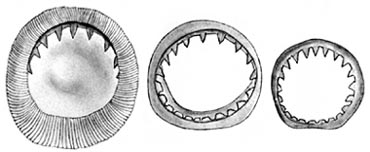
Figure. Oral views of tentacular club suckers of C. sirventi. Left - Manus sucker with outer ring intact. Middle - Manus sucker showing inner ring only. Right - Dactylus sucker showing inner ring only.Drawings from Young and Roper (1969).
- Head
- Beaks: Descriptions can be found here: Lower beak; upper beak.
- Beaks: Descriptions can be found here: Lower beak; upper beak.
- Mantle
- Tail present.
- Tail present.
- Fins
- Fins large, oval, length about 80% of ML in subadults.
- Fins large, oval, length about 80% of ML in subadults.
- Photophores
- Large photophore on ink sac.
- Irregular series of small photophores apparently at edge of iris; large photophore on ventral surface of eyeball.
- Gladius
- Gladius with a secondary conus.
Nomenclature
A second species, Cycloteuthis akimushkini Filippova, 1968, has been described. This description was based on a very large specimen and apparent differences between this species and C. sirventi may be due to size effects alone. This species is considered to be a synonym of C. sirventi at present.
Life History
C. serventyi has a very distinctive paralarva. The second arms are very long and a thick, transparent dermal layer is present in the integument. Each eye is on a stalk but, unlike many cranchiids, the optic lobe is attached to the central brain and long retinal nerves connect it to the eye.
References
Clarke, M. R. 1986. A Handbook for the Identification of Cephalopod Beaks. Clarendon Press, Oxford. 273 pp.
Filippova, J. A. 1968. A new species of the genus Cycloteuthis. Malacol. Rev., 1: 119-124.
Nesis, K. N. 1982. Abridged key to the cephalopod mollusks of the world's ocean. 385,ii pp. Light and Food Industry Publishing House, Moscow. (In Russian.). Translated into English by B. S. Levitov, ed. by L. A. Burgess (1987), Cephalopods of the world. T. F. H. Publications, Neptune City, NJ, 351pp.
Young, R. E. and C. F. E. Roper. 1969. A monograph of the Cephalopoda of the North Atlantic: The family Cycloteuthidae. Smithsonian Contributions to Zoology No. 5:1-24.
About This Page
Page copyright © 2019
 Page: Tree of Life
Cycloteuthis . Cycloteuthis sirventi .
The TEXT of this page is licensed under the
Creative Commons Attribution-NonCommercial License - Version 3.0. Note that images and other media
featured on this page are each governed by their own license, and they may or may not be available
for reuse. Click on an image or a media link to access the media data window, which provides the
relevant licensing information. For the general terms and conditions of ToL material reuse and
redistribution, please see the Tree of Life Copyright
Policies.
Page: Tree of Life
Cycloteuthis . Cycloteuthis sirventi .
The TEXT of this page is licensed under the
Creative Commons Attribution-NonCommercial License - Version 3.0. Note that images and other media
featured on this page are each governed by their own license, and they may or may not be available
for reuse. Click on an image or a media link to access the media data window, which provides the
relevant licensing information. For the general terms and conditions of ToL material reuse and
redistribution, please see the Tree of Life Copyright
Policies.
- First online 26 March 2019
- Content changed 26 March 2019
Citing this page:
Tree of Life Web Project. 2019. Cycloteuthis . Cycloteuthis sirventi . Version 26 March 2019 (temporary). http://tolweb.org/Cycloteuthis_sirventi/149702/2019.03.26 in The Tree of Life Web Project, http://tolweb.org/




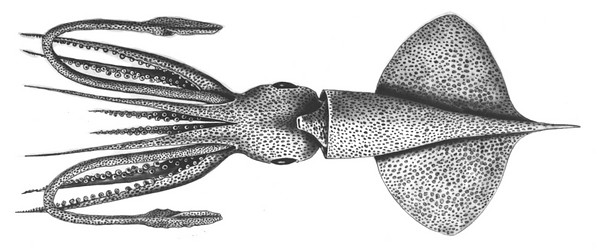

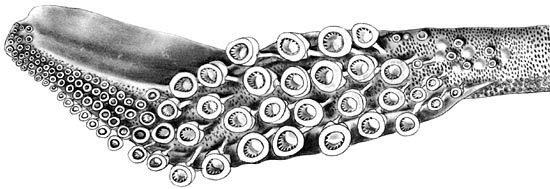
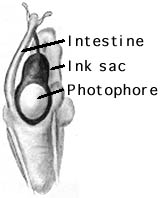

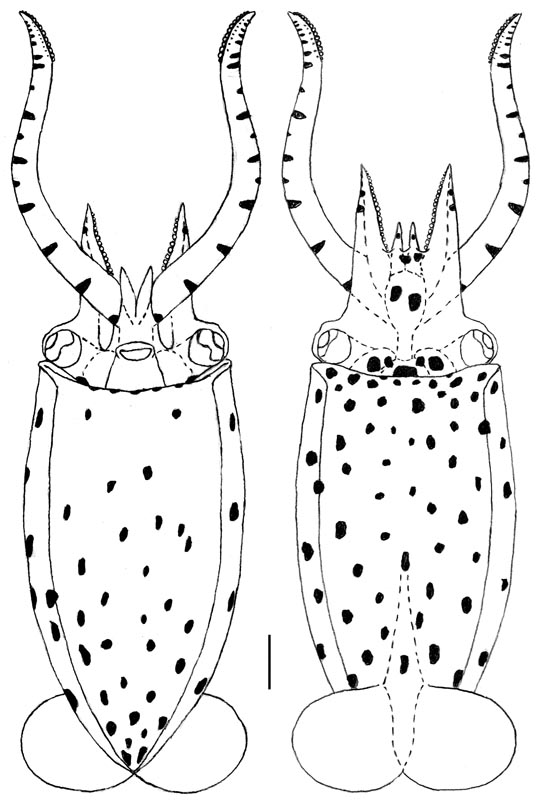
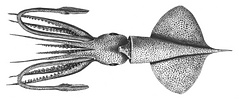


 Go to quick links
Go to quick search
Go to navigation for this section of the ToL site
Go to detailed links for the ToL site
Go to quick links
Go to quick search
Go to navigation for this section of the ToL site
Go to detailed links for the ToL site